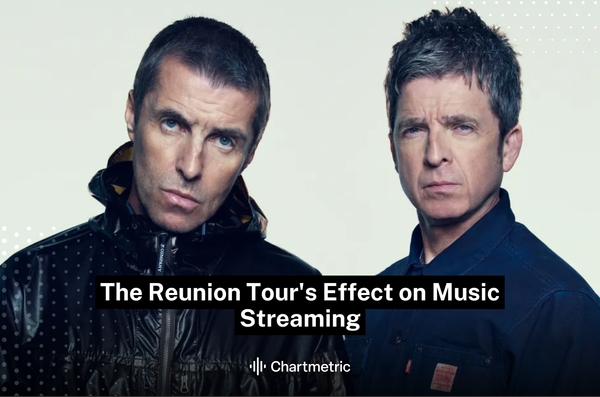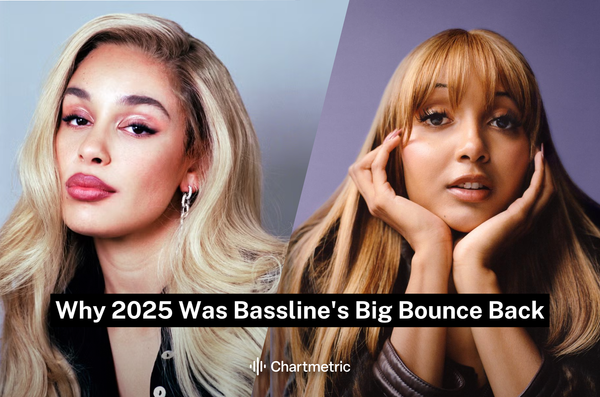The summer of 2023 was defined by Taylor Swift’s The Eras Tour and Beyoncé’s Renaissance World Tour. The summer of 2024 belonged to Brat, along with the stratospheric rise of pop stars like Sabrina Carpenter and Chappell Roan. Now, most of the way through the summer of 2025, pop music fans are confused. There are no omnipresent hits to soundtrack poolside days or sweaty nights. Everyone is asking the same question: “Where was 2025’s Song of the Summer?” Here at Chartmetric, we even ran our own analysis into why 2025 has no culturally defining hit.
Though the summer of 2025 does not have an essential hit song from a pop diva, the season does have its key cultural moment: the Reunion Tour. Reunion tours–like Oasis’s (CM Rank: 234) Live ‘25 Tour and Black Sabbath’s (CM rank: 378) Back to the Beginning show–are driving surges in streaming and social media activity. One glance at the omnivorous crowds at Oasis’s Live ‘25 Tour and 2025’s song of the summer becomes increasingly obvious: it’s thirty years old, and it was likely written by Liam and Noel Gallagaher.
📍Wembley #OasisLive25 pic.twitter.com/Tg3TT4pNHJ
— Oasis (@oasis) July 26, 2025
Since Oasis began their Live ‘25 Tour, the band has seen dramatic growth in their streaming audience on Spotify. The tour kicked off in Cardiff on July 4th which was the first time brothers Liam and Noel Gallagher played together since 2009. At the time, the band had around 24M monthly listeners on Spotify. One month into the tour, the band grew to 30.7M monthly listeners, a growth of over 6M monthly listeners in just four weeks. As they toured the United Kingdom throughout the month, Oasis saw consistent growth of over 100K new listeners per day. The last time Oasis saw such tremendous spikes in streams was when the band announced the long-awaited reunion in August 2024.
The growth extends beyond just streaming on Spotify. Prior to the tour on June 26th, the band had a following of around 887.8K on TikTok. One month later, the group had a 41.1% increase in their following to 1.2M. The demographics for Oasis’s TikTok audience skews towards the 18-24 age group, with 51.3% of their following falling under that age bracket. Evidently, the reunion tour helped Oasis reach fans of a younger generation. Now, the majority of their TikTok following are fans who were not even born when the band’s signature albums like Definitely Maybe or (What’s The Story) Morning Glory? came out.
Oasis are not the only band to benefit this summer from the Reunion Tour effect. Black Sabbath reunited their original lineup, including Ozzy Osbourne on vocals, for their final show ever on July 5th. The benefit concert, titled Back to the Beginning, was the first time since 2005 that the original lineup performed live together. Almost three weeks after the farewell concert, Osbourne passed away on July 22nd. News of his death led to immediate spikes in Black Sabbath’s streaming and social media as fans mourned the loss of the heavy metal pioneer. However, Sabbath’s listenership was increasing since the Back to the Beginning performance, notwithstanding Osborne’s death.
For the majority of 2025, Black Sabbath hovered around 13M monthly listeners. On July 4th, the day before the performance, the band held steady at 16M listeners. Just one week later on July 12th, the band jumped to 18.4M monthly listeners, a 15% increase in just seven days. Throughout the first half of 2025, Black Sabbath averaged 1.03M YouTube views per day. Unsurprisingly, that average grew to 2.14M YouTube views per day in the week following Back to the Beginning.
Obviously, both Oasis and Black Sabbath’s well-known hits already had significant streams preceding their respective reunion shows.
Still, the Reunion Tour Effect led to the faster accumulation of streams on the band’s biggest hits. For example, “Wonderwall” grew from 2.38B streams on July 4th to 2.43B streams one month later on August 4th. That’s an increase of over 40 million. By comparison, the song grew by 27.9M streams between June 4th and July 4th. “Don’t Look Back In Anger” saw similar growth in the month since Oasis kicked off their tour. Between June 4th and July 4th, the track grew by 17.1M streams. But between July 4th and August 4th, the track was streamed 28.6M. The take away is: the Reunion Tour is driving more listeners back to Oasis music.
Black Sabbath also saw more streams on the band’s hits, though on a smaller scale than Oasis. Between June 14th and July 14th, “Iron Man” grew by 10.9M Spotify streams while “War Pigs” grew by 8.5M streams. By comparison, those same tracks grew by 8.4M and 6.6 M streams respectively in the prior month.
Even Oasis’s deep cuts have seen a lift from the tour. “Shakermaker” is from the band’s landmark debut album Definitely Maybe, but the song is not included on the setlist for the tour. Between June 4th and July 4th, the song earned 485.7K new streams on Spotify. But in the following month since the tour kicked off, the song received over 1M streams. Similarly, “Hey Now!” is from (What’s The Story) Morning Glory?, the band’s best-selling album featuring their biggest hits like “Wonderwall” and “Champagne Supernova” but is also not on the setlist. “Hey Now!” increased by 566.9Kstreams from June 4th to July 4th, but it grew by 1.4M in the following month. This suggests that fans are returning to Oasis’s albums in full, rediscovering tracks both on and off the setlist. Even songs from outside the band’s “prime” era benefited. “Lyla,” the lead single to the band’s 2005 album Don’t Believe The Truth, well after the apex of the Britpop era, saw faster-growing streams than prior to the tour.
No, 2025 has not seen a new pop diva taking the world by storm with a “Song of the Summer.” However, a different trend has taken place. Thanks to their highly successful reunion tours, Oasis and Black Sabbath have seen renewed interest from fans across all platforms. Even Creed, the late ‘90s rock band historically almost universally-despised by critics and tastemaskers (voted the Number One Worst Band of the 1990s in a Rolling Stone reader’s poll), has seen the benefits of the Reunion Effect with their Summer of ‘99 Tour, the band’s first tour since 2012. Creed’s monthly listeners grew from 11.3M at the start of the year to 13.9M .With theReunion Effect, what’s old is new again, and this year’s summer playlist isn’t so far away from a CD mix from 30 years ago.





